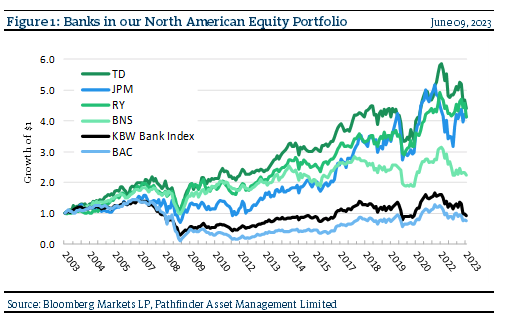Our Bank Positioning
Two weeks ago, we wrote about our review of the first quarter earnings season. The companies that we invest in report financial data and management commentary on a regular basis. It is an important part of our investment process because we can check in on the progress of the companies that we own, as well as management’s expectations for the future of their business operations. Internally, we informally declare the “end-of-earnings season” when the results of the Canadian banks are published. It has been some time since we have discussed the banks, so we thought we would provide our thoughts after this most recent earning season. We own the large money center Canadian and US banks in our North American portfolio. They have been successful investments over time (please see Figure 1) but have had some difficulty recently with all the issues that have been well publicized over the last several months. Our position is as follows:
• JPMorgan Chase (JPM US) is our biggest weight and our favorite bank. Its size and operational efficiency provide a substantial competitive advantage over other banks.
• Royal Bank of Canada (RY CN), also overweight, is, in our opinion, a Canadian version of JPM.
• Toronto-Dominion Bank (TD CN) is a high-quality traditional Canadian and US bank with lower capital markets exposure and excess capital in a time of uncertainty.
• Bank of Nova Scotia (BNS CN) is the most international of the Canadian banks with exposure to Latin America. It is equal weight in our portfolios, and we will adjust its weight solely based on valuation.
• Bank of America Corp (BAC US) is our smallest position and most recent addition based on valuation. BAC is traditionally a riskier bank, and we are considering removal given recent events.

“This means that” we believe fundamentally that the large money center banks have a competitive advantage over their smaller peers. We also believe that Canada tends to be an easier place to operate than the US. While generally we would always maintain some level of ownership of banks in our portfolios over time, the amount will fluctuate depending on the environment. More recently, the operating environment has become marginally difficult. While increased interest rates bring increased margin spreads, it also brings increased credit risk. There has also been significant expense creep and a potential increase in required equity funding. While the absolute level of our commitment to the sector will most likely decrease, we will hold our exposure in the portfolio to only the highest quality companies.
National Instrument 31-103 requires registered firms to disclose information that a reasonable investor would expect to know, including any material conflicts with the firm or its representatives. Doug Johnson and/or Pathfinder Asset Management Limited are an insider of companies periodically mentioned in this report. Please visit www.paml.ca for full disclosures.
Changes in Leverage. We are increasing the asset ceiling to 2.0 times the market value of equity for Pathfinder International Fund and Pathfinder Real Fund to be consistent with Pathfinder Partners’ Fund and Pathfinder Resource Fund.
*All returns are time weighted and net of investment management fees. Returns from the Pathfinder Partners’ Fund and Partners’ Real Return Plus Fund are presented based on the masters series of each fund. The Pathfinder Core: Equity Portfolio and The Pathfinder Core: High Income Portfolio are live accounts. These are actual accounts owned by the Pathfinder Chairman (Equity) and client (High Income) which contain no legacy positions, cash flows or other Pathfinder investment mandates or products. Monthly inception dates for each fund and portfolio are as follows: Pathfinder Core: Equity Portfolio (January 2011), Pathfinder Core: High Income Portfolio (October 2012) Partners’ Fund (April 2011), Partners’ Real Return Plus Fund (April, 2013), and Partners’ Core Plus Fund (November 2014).
Pathfinder Asset Management Limited (PAML) and its affiliates may collectively beneficially own in excess of 10% of one or more classes of the issued and outstanding equity securities mentioned in this newsletter. This publication is intended only to convey information. It is not to be construed as an investment guide or as an offer or solicitation of an offer to buy or sell any of the securities mentioned in it. The author has taken all usual and reasonable precautions to determine that the information contained in this publication has been obtained from sources believed to be reliable and that the procedures used to summarize and analyze such information are based on approved practices and principles in the investment industry. However, the market forces underlying investment value are subject to sudden and dramatic changes and data availability varies from one moment to the next. Consequently, neither the author nor PAML can make any warranty as to the accuracy or completeness of information, analysis or views contained in this publication or their usefulness or suitability in any particular circumstance. You should not undertake any investment or portfolio assessment or other transaction on the basis of this publication, but should first consult your portfolio manager, who can assess all relevant particulars of any proposed investment or transaction. PAML and the author accept no liability of any kind whatsoever or any damages or losses incurred by you as a result of reliance upon or use of this publication.